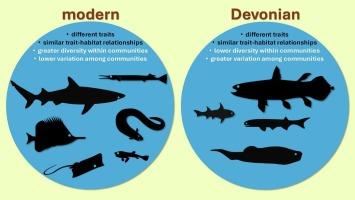晚泥盆世至今3.8亿年间鱼类群落特征空间差异
IF 2.7
2区 地球科学
Q2 GEOGRAPHY, PHYSICAL
Palaeogeography, Palaeoclimatology, Palaeoecology
Pub Date : 2025-09-18
DOI:10.1016/j.palaeo.2025.113294
引用次数: 0
摘要
生态群落中物种特征的多样性和分布决定了生态群落的功能。虽然现代鱼类群落在相似的栖息地保存性状空间,但对性状空间在长时间或不同栖息地之间的变化知之甚少。我们通过比较三个晚泥盆世鱼类群落——热带珊瑚礁(澳大利亚Gogo)、热带河口(加拿大密瓜沙)和温带淡水系统(澳大利亚Canowindra)——与来自不同栖息地的六个现代群落,研究了鱼类特征多样性是如何随时间和空间变化的。反映群落内部多样性(功能丰富度)和物种相似性(功能最近邻距离)的特征空间指标表明,晚泥盆世群落的得分与现代群落相似。然而,它们的功能不如它们最接近的现代类似物丰富,而且它们的物种往往在功能上彼此不同。描述性状空间位置的指标(质心距离和超体积重叠)表明现代群落彼此相似,Gogo和Miguasha相似但与现代群落不同,Canowindra与其他所有群落不同。这种模式表明晚泥盆世群落之间存在与时代相关的分化和实质性的异质性。除了时间变化外,我们还发现了与栖息地类型和气候带相关的一致性差异。珊瑚礁和热带群落的功能最丰富,而河口和温带群落的功能近邻得分最高。这些结果表明,鱼类群落性状空间随时间、生境和气候的变化而变化,表明:(1)鱼类性状空间的不稳定性;(2)进化历史、环境过滤和随机性影响着群落聚集。本文章由计算机程序翻译,如有差异,请以英文原文为准。

Trait-space disparity in fish communities spanning 380 million years from the Late Devonian to present
The diversity and distribution of species' traits in an ecological community determine how it functions. While modern fish communities conserve trait space across similar habitats, little is known about trait-space variation through deep time or across different habitats. We examined how fish trait diversity varies through space and time by comparing three Late Devonian fish communities — a tropical reef (Gogo, Australia), a tropical estuary (Miguasha, Canada), and a temperate freshwater system (Canowindra, Australia) — with six modern communities from diverse habitats. Trait-space metrics reflecting within-community diversity (functional richness) and species similarity (functional nearest-neighbour distance) indicated Late Devonian communities had scores similar to modern communities. However, they were less functionally rich than their closest modern analogues, and their species tended to be more functionally distinct from one another. Metrics describing location in trait space (centroid distances and hypervolume overlap) showed modern communities were similar to each other, Gogo and Miguasha were similar but distinct from modern communities, and Canowindra was distinct from all others. This pattern suggests period-associated differentiation and substantial heterogeneity among some Late Devonian communities. In addition to temporal changes, we found consistent differences associated with habitat type and climate zone. Reef and tropical communities were the most functionally rich, whereas functional nearest-neighbour scores were highest in estuarine and temperate communities. These results indicate fish community trait space varies with time, habitat and climate, suggesting (i) lability in fish trait space and (ii) that evolutionary history, environmental filtering, and stochasticity influence community assembly.
求助全文
通过发布文献求助,成功后即可免费获取论文全文。
去求助
来源期刊
CiteScore
5.90
自引率
10.00%
发文量
398
审稿时长
3.8 months
期刊介绍:
Palaeogeography, Palaeoclimatology, Palaeoecology is an international medium for the publication of high quality and multidisciplinary, original studies and comprehensive reviews in the field of palaeo-environmental geology. The journal aims at bringing together data with global implications from research in the many different disciplines involved in palaeo-environmental investigations.
By cutting across the boundaries of established sciences, it provides an interdisciplinary forum where issues of general interest can be discussed.

 求助内容:
求助内容: 应助结果提醒方式:
应助结果提醒方式:


